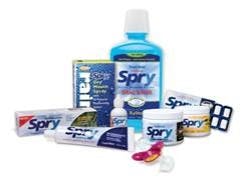The sweetest way for healthy teeth: Xylitol
By Lisa Stillman RDH, BS
“Hey Kids, Xylitol five times a day keeps cavities away!”Wouldn’t that be a miracle? And it is! Xylitol is the miracle natural sweetener with the capacity to help rid those nasty bugs that cause caries and sticky plaque when used five times a day! And the best part is that is tastes great … just like sugar! Xylitol is a natural sweetener that comes from the fibers in plants such as fruits, vegetables and corn cobs. We consume about 8-10 grams daily in our diet and humans naturally formulate xylitol in the liver and it is essential in the conversion of food to energy. The beauty of Xylitol is that it consists of a 5 carbon chain. Bacteria cannot digest a 5 carbon chain. Xylitol tricks the bacteria into thinking it is a food source and ingests the sweetener but cannot digest it, therefore it cannot produce sticky polysaccharides that allow bacteria to stick to one another, the teeth or tissues. The affected bacteria break away from the existing biofilm reducing the plaque and harmful Strep Mutans.
“Hey Kids, Xylitol five times a day keeps cavities away!”Wouldn’t that be a miracle? And it is! Xylitol is the miracle natural sweetener with the capacity to help rid those nasty bugs that cause caries and sticky plaque when used five times a day! And the best part is that is tastes great … just like sugar! Xylitol is a natural sweetener that comes from the fibers in plants such as fruits, vegetables and corn cobs. We consume about 8-10 grams daily in our diet and humans naturally formulate xylitol in the liver and it is essential in the conversion of food to energy. The beauty of Xylitol is that it consists of a 5 carbon chain. Bacteria cannot digest a 5 carbon chain. Xylitol tricks the bacteria into thinking it is a food source and ingests the sweetener but cannot digest it, therefore it cannot produce sticky polysaccharides that allow bacteria to stick to one another, the teeth or tissues. The affected bacteria break away from the existing biofilm reducing the plaque and harmful Strep Mutans.
Studies show that Xylitol:• When used by mothers, prohibits the transmission of Strep Mutans from mother to child• Strengthens newly erupted teeth as well as those exposed to dry mouth or high acidic food• When discontinued, has lasting caries reduction effects for 2-3 years.• Increases saliva, raises PH, and enhances remineralization• Reduces damage to teeth while wearing fixed orthodontics• Gum chewing reduces the occurrence of otitis media by 40%Instead of viewing ages 5-12 as the cavity prone years, we can now see this time period as the best opportunity to offer xylitol to strengthen teeth for life! The recommended exposure protocol for xylitol is 5-8 times a day with a total of 8-10 grams per day … Strive for Five! Xylitol products vary and reading labels is important. For example, if the label on the product lists other sweeteners such as sorbitol, which is a 6 carbon chain, then xylitol will be less effective. Make sure that xylitol is the first ingredient and that there are no other sweeteners on the label.
An easy way of incorporating xylitol products into the regular routine of a child would be to:1) Use xylitol toothpaste and mouth rinse for use in the morning and at bedtime2) Offer 100% sweetened xylitol gum between meals 3 times a day for 5 minutes of chewing for proper exposure time3) For variety: offer xylitol candy, mints or xylitol crystals sprinkled over fruit and cerealAn easy way for infants and toddlers to get the required amount of xylitol is to use xylitol ingestible tooth gel applied 4-5 times a day by rubbing it on the gums, putting it on a toddler toothbrush, or inside a medicinal delivery pacifier. This works to reduce the Strep Mutans from being readily available when the primary teeth erupt. The Pacifier method also helps to reduce ear infections by exposing xylitol to the back of the throat where the openings for the Eustachian tubes reside. One of the concerns parents have about introducing xylitol to babies is that they will enjoy the taste and encourage sweets at an early age. Studies show that the taste for sweets is innate and not learned.Xylitol testing has found this natural miracle sweetener to be completely safe for all ages. It is well tolerated by children up to 40 grams per day. Exceeding that amount may cause a laxative effect until the body adjusts. It is important to note that dogs and ferrets cannot tolerate Xylitol and it is harmful to their metabolic system. Keep all xylitol away from pets.Quality Xylitol products can be found more readily in health food stores and pharmacies but it is starting to appear in regular grocery stores.
References
H. Olsson, C. J. Spak, T. Axell, “The effect of a chewing gum on salivary secretion, oral mucosal friction and the feeling of dry mouth in xerostomic patients,” Acta Odontologica Scandinavia vol. 49, pp. 273-279, 1991.P. P. Hujoel, K. K. Mäkinen, C. A. Bennett, et al., “The optimum time to initiate habitual xylitol gum-chewing for obtaining long-term caries prevention,” Journal of Dental Research, vol. 78, no. 3, pp. 797–803, 1999.P. Isokangas, E. Söderling, K. Pienihäkkinen, P. Alanen, “Occurrence of dental decay in children children after maternal consumption of xylitol chewing gum, a follow-up from 0 to 5 years of age,” Journal of Dental Research, vol. 79, no. 11, pp. 1885-1889, Nov. 2000.S. E. Coldwell, T. K. Oswald, D. R. Reed, “A marker of growth differs between adolescents with high vs. low sugar preference,” Behavior Physiology vol. 96, no. 23, pp. 574-580, March, 2009.K. P. Isotupa, S. Gunn, C. Y. Chen, D. Lopatin, K. K. Mäkinen, “Effect of polyol gums on dental plaque in orthodontic patients,” American Journal of Orthodontics and Dentalfacial Orthopedics vol. 107, pp. 497-504, 1995.Y. Miake, M. Takahashi, Y. Saeki, T. Yanagisawa, “Effect of xylitol on remineralization of demineralized enamel,” The Shikwa Gakuho, vol. 99, pp. 393-399, 1999 (Japanese).T. Yanagisawa, Y. Miake, “Prevention of caries and restoration of initial enamel caries by remineralization enhanced with xylitol +2 gum,” Finnish Dental Journal, vol. 13, supplement 1, pp. 44-49, 2006.M. Brin, O. N. Miller, “The safety of oral xylitol,” in: “Sugars in Nutrition” (H. L. Sipple, K. W. McNutt, eds), pp. 591-605, Academic Press, New York 1974.H. K. Åkerblom, T. Koivukangas, et al, “The tolerance of increasing amounts of dietary xylitol in children,” International Journal of Vitamin and Nutrition Research vol. 22 (supplement), pp. 53-66, 1982.M. Uhari, T. Kontiokari, M. Koskela, M. Niemelä, “Xylitol chewing gum in prevention of acute otitis media: double blind randomised trial. British Medical Journal vol. 313, no. 7066, pp. 1180-1184, 1996.
H. Olsson, C. J. Spak, T. Axell, “The effect of a chewing gum on salivary secretion, oral mucosal friction and the feeling of dry mouth in xerostomic patients,” Acta Odontologica Scandinavia vol. 49, pp. 273-279, 1991.P. P. Hujoel, K. K. Mäkinen, C. A. Bennett, et al., “The optimum time to initiate habitual xylitol gum-chewing for obtaining long-term caries prevention,” Journal of Dental Research, vol. 78, no. 3, pp. 797–803, 1999.P. Isokangas, E. Söderling, K. Pienihäkkinen, P. Alanen, “Occurrence of dental decay in children children after maternal consumption of xylitol chewing gum, a follow-up from 0 to 5 years of age,” Journal of Dental Research, vol. 79, no. 11, pp. 1885-1889, Nov. 2000.S. E. Coldwell, T. K. Oswald, D. R. Reed, “A marker of growth differs between adolescents with high vs. low sugar preference,” Behavior Physiology vol. 96, no. 23, pp. 574-580, March, 2009.K. P. Isotupa, S. Gunn, C. Y. Chen, D. Lopatin, K. K. Mäkinen, “Effect of polyol gums on dental plaque in orthodontic patients,” American Journal of Orthodontics and Dentalfacial Orthopedics vol. 107, pp. 497-504, 1995.Y. Miake, M. Takahashi, Y. Saeki, T. Yanagisawa, “Effect of xylitol on remineralization of demineralized enamel,” The Shikwa Gakuho, vol. 99, pp. 393-399, 1999 (Japanese).T. Yanagisawa, Y. Miake, “Prevention of caries and restoration of initial enamel caries by remineralization enhanced with xylitol +2 gum,” Finnish Dental Journal, vol. 13, supplement 1, pp. 44-49, 2006.M. Brin, O. N. Miller, “The safety of oral xylitol,” in: “Sugars in Nutrition” (H. L. Sipple, K. W. McNutt, eds), pp. 591-605, Academic Press, New York 1974.H. K. Åkerblom, T. Koivukangas, et al, “The tolerance of increasing amounts of dietary xylitol in children,” International Journal of Vitamin and Nutrition Research vol. 22 (supplement), pp. 53-66, 1982.M. Uhari, T. Kontiokari, M. Koskela, M. Niemelä, “Xylitol chewing gum in prevention of acute otitis media: double blind randomised trial. British Medical Journal vol. 313, no. 7066, pp. 1180-1184, 1996.
Lisa Stillman RDH, BS, is a clinical dental hygienist and the Northeast Xylitol Educator for Xlear, Inc/Spry, and is the recipient of the 2008 Sunstar/RDH Award of Distinction.




